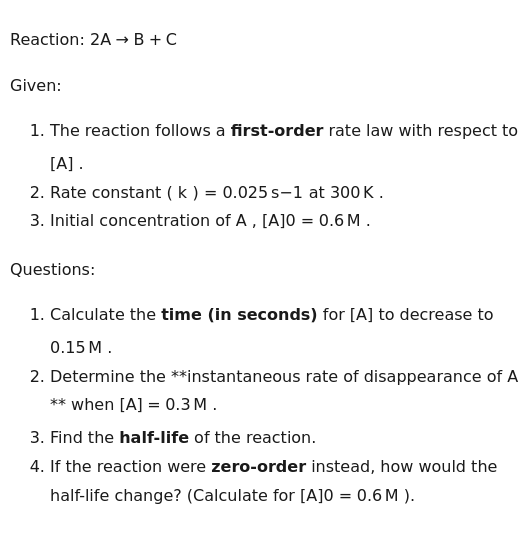Question
Question: Reaction: \[ 2A \rightarrow B + C \] Given: 1. The reaction follows a **first-order** rate law wi...
Reaction: 2A→B+C
Given:
- The reaction follows a first-order rate law with respect to [A].
- Rate constant (k) = 0.025s−1 at 300K.
- Initial concentration of A, [A]0=0.6M.
Questions:
- Calculate the time (in seconds) for [A] to decrease to 0.15M.
- Determine the instantaneous rate of disappearance of A when [A]=0.3M.
- Find the half-life of the reaction.
- If the reaction were zero-order instead, how would the half-life change? (Calculate for [A]0=0.6M).

- The time for [A] to decrease to 0.15M is 55.45s.
- The instantaneous rate of disappearance of A when [A]=0.3M is 0.0075M s−1.
- The half-life of the reaction is 27.72s.
- If the reaction were zero-order, the half-life would be 12s.
Solution
The problem involves applying concepts of chemical kinetics, specifically integrated rate laws, differential rate laws, and half-life calculations for first-order and zero-order reactions.
1. Calculate the time (in seconds) for [A] to decrease to 0.15M.
The reaction is first-order with respect to [A]. The integrated rate law for a first-order reaction is: ln([A]0[A]t)=−kt Rearranging to solve for time t: t=k1ln([A]t[A]0) Given:
- Initial concentration, [A]0=0.6M
- Final concentration, [A]t=0.15M
- Rate constant, k=0.025s−1
Substitute the values: t=0.025s−11ln(0.15M0.6M) t=40s×ln(4) t=40s×1.38629 t=55.45s
2. Determine the instantaneous rate of disappearance of A when [A]=0.3M.
For a first-order reaction, the instantaneous rate of disappearance of A is given by the differential rate law: Rate=−dtd[A]=k[A] Given:
- Rate constant, k=0.025s−1
- Concentration of A, [A]=0.3M
Substitute the values: Rate=(0.025s−1)×(0.3M) Rate=0.0075M s−1
3. Find the half-life of the reaction.
For a first-order reaction, the half-life (t1/2) is independent of the initial concentration and is given by: t1/2=kln(2) Given:
- Rate constant, k=0.025s−1
Substitute the value: t1/2=0.025s−10.6931 t1/2=27.72s
4. If the reaction were zero-order instead, how would the half-life change? (Calculate for [A]0=0.6M).
If the reaction were zero-order, we assume the numerical value of the rate constant remains 0.025, but its units would be M s−1 for a zero-order reaction (i.e., kzero−order=0.025M s−1). For a zero-order reaction, the half-life (t1/2) depends on the initial concentration and is given by: t1/2=2k[A]0 Given:
- Initial concentration, [A]0=0.6M
- Hypothetical zero-order rate constant, k=0.025M s−1
Substitute the values: t1/2=2×0.025M s−10.6M t1/2=0.05M s−10.6M t1/2=12s Compared to the first-order half-life (27.72 s), the half-life would be significantly shorter (12 s) if the reaction were zero-order with the same numerical rate constant.
Explanation of the solution:
- Time for [A] to decrease: Use the integrated rate law for a first-order reaction, t=k1ln([A]t[A]0), substituting the given initial and final concentrations and the rate constant.
- Instantaneous rate: Apply the differential rate law for a first-order reaction, Rate=k[A], using the given rate constant and concentration of A.
- Half-life (first-order): Calculate the half-life using the formula for a first-order reaction, t1/2=kln(2), which is independent of concentration.
- Half-life (zero-order): For a hypothetical zero-order reaction, assume the numerical value of k is the same but its units are M s−1. Use the half-life formula for a zero-order reaction, t1/2=2k[A]0, and the given initial concentration.
